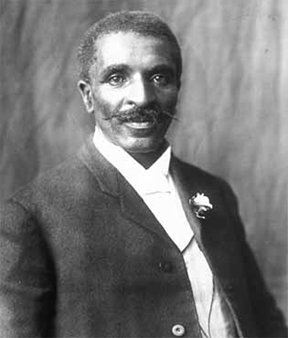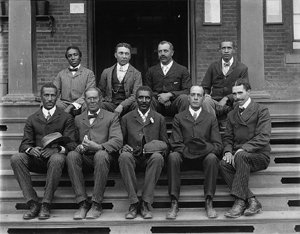George Washington Carver
Inventions - History - Quotes - Film

George Washington Carver's inventions are so familiar to us today that we take them for granted, yet we would be at a great loss without them.
It's hard to imagine the fate of Southern US agriculture if Dr. Carver hadn't promoted crop rotation, growing peanuts, soybeans, and sweet potatoes, while enhancing their market value by inventing hundreds of products using them.
Carver's invention of plant derived products, and teaching farmers how to improve their soil through crop rotation, are his greatest gifts to us. George's curiosity, determination, love of nature, and desire to help people were guiding factors in his life.
"Where there is no vision, there is no hope." GW Carver
Carver's Early Life
This great agronomist, agricultural chemist, and master integrator was born in 1864 near Diamond Grove, Missouri.
Infant George and his slave mother were kidnapped by Confederate night raiders. Farmer Moses Carver searched for and recovered baby George after the Civil War. George's mother was never found. Moses and Susan Carver raised George and his brother as their own children.
George fell in love with nature while growing up on the Carver farm. George developed a close understanding of, and connection with plants, earning him childhood nickname 'The Plant Doctor'.
"If you love it enough, anything will talk with you." GW Carver
Nature to Art
George taught himself to paint after seeing paintings at a neighbors house. He collected pigments from the land, made paints with these pigments, and began painting with brushes he made from found items.
This artistic interest would help Carver later in his pursuit of knowledge.
"How far you go in life depends on your being tender with the young, compassionate with the aged, sympathetic with the striving, and tolerant of the weak, and strong. Because someday in your life you will have been all of these." GW Carver
Education under Segregation
At the age of 12, Carver moved away from his adoptive parents to Newton County in Missouri to study in a one room schoolhouse at the Lincoln School for Negro Children.
George worked as a farmhand for room and board at the Watkins' house next door to the school. After the Lincoln School George attended Minneapolis High School in Kansas.
"Our creator is the same and never changes despite the names given Him by people here and in all parts of the world. Even if we gave Him no name at all, He would still be there,within us, waiting to give us good on this earth." GW Carver
Simpson College
Art to Horticulture
In 1890 George entered Iowa's Simpson College as an art student. Carver's art teacher, Etta Budd, noticed the genius in George's plant art and advised him to transfer into horticulture. Ms. Budd may have thought horticulture offered more chance of success than art for a black man in the late 19th century.
"I love to think of nature as an unlimited broadcasting station, through which God speaks to us every hour, if we will only tune in." GW Carver
Iowa State College of Agriculture
Bachelor and Master of Science Degrees
Carver transferred to the Iowa State College of Agriculture in Ames in 1891, becoming the first black student there. He was appointed as faculty member at Iowa State after completing his Bachelor of Science degree in 1894. George earned his Master of Science degree in bacterial botany and agriculture in 1896 at Ames.
"When I was young, I said to God, god, tell me the mystery of the universe. But God answered, that knowledge is for me alone. So I said, god, tell me the mystery of the peanut. Then God said, well, George, that's more nearly your size." GW Carver
Tuskegee Institute
Teaching, Helping, Inventing

Booker T. Washington convinced Carver to move to Alabama as Director of Agriculture at the 'Tuskegee Normal and Industrial Institute for Negroes' in 1896. Arriving in Alabama in 1897, Carver advised local cotton farmers to rotate their fields with soil enriching crops; peanuts, peas, soybeans, and sweet potatoes. Farmers were unable to comply because banks would only loan seed money to grow cotton.
Cotton was king in the south until the boll weevil decimated the crop in the early 1900's. The boll weevil invaded all USA cotton crops by 1922, forcing southern US farmers and investors to embrace peanuts, soybeans, and sweet potatoes. George Washington Carver's inventions using these three crops created profitable new markets for them.
In 1916, Coffee County agent John Pittman, and cotton merchant/banker Moultrie Sessions encouraged farmers in Coffee County, Alabama to grow peanuts. The transition from cotton farming to peanut farming created a profitable new era in southeast Alabama that benefited the soil, farmers, consumers, and the local communities throughout the 20th century.
Georg Washington Carver's Inventions
George Washington Carver's Inventions using Peanuts
- Soaps - Laundry, Toilet, Antiseptic
- Sweeping Compound
- Massage Oil
- Castor Substitute
- Goiter Treatment
- Laxatives
- Lotions - Hand, Face
- Creams - Face, Vanishing, Baby, Shaving
- Face Bleach and Tan Remover
- Shampoo
- Oil for Hair and Scalp
- Pomades - Scalp, Skin - US Patent 1,522,176
- Face Ointment
- Glycerin
- Face Powder
- Tetter and Dandruff Cure
- Dyes for Leather
- Dyes for Cloth (30 colors)
- Wood Stains (17 colors)
- Paints
- Papers - White, Colored, Newsprint paper from vines, Kraft paper from hulls, Coarse paper from skins
- Pesticide
- Glue
- Wood Filler
- Metal Polish
- Plastics
- Axel Grease
- Lubricating Oil
- Lamp Oil
- Diesel Fuel
- Ink - Printers, Writing
- Rubber
- Coke (from hulls)
- Washing Powder
- Linoleum
- Wall Boards (11 types)
- Insulating Board (18 types)
- Charcoal (from shells)
- Nitroglycerin
- Soil Conditioner
Have a Question or Comment about George Washington Carver?
Share your knowledge of George Washington Carver, or ask a question about him here.
What Other Visitors Have Posted about GW Carver
Click below to see contributions from other visitors to this page.
WUT!?
HE MADE IT ALL FROM ONE SINGULAR PEANUT!?
WTH THAT IS SO COOL!
Myth buster - Did George Washington Carver Invent Peanut Butter?
George Washington Carver did not invent peanut butter for that is just a myth. He invented a lot of other things that involved peanuts so people started …
Bruhhhh..
Are you saying that Carver was the one who made those things? With only using peanut?! I am shocked right now. I'll use him for my project later using …
Did George Washington Carver Invent Peanut Butter?
Didn't he invent peanut butter? Why isn't it on the list?
GW Carver's Soybean Inventions For Army
Were Dr. Carver's inventions using soybeans for paint, glue, plastic and dyes initially for the United States Army?
George Washington Carver and Pecans
I would like to know what he made with pecans.
Henry Ford and GW Carver
Did Henry Ford ever contribute to George Washington Carver's Tuskegee Laboratory while Mr. Carver was living?
GW Carver and Peanut Butter
Did GW Carver make peanut butter? 🥜
Question about Plastic from Peanuts
What did he make plastic out of?
Did Carver invent Peanut Butter?
Did he or did he not make peanut butter.
Invention of Postage Stamp Glue
What did George Washington Carver use to make postage stamp glue?
Did GW Carver invent white wash?
Did George Washington Carver invent and promote the use of white washing?
Thank you.
Dave Carlson
Plastic from Peanuts
How did George Washington Carver make plastic out of peanuts?
Biography of George Washington Carver
In grammar school, our library had a group of blue books & each one was a biography of someone very interesting....most of the time. Well, when I was young …
Question about George Washington Carver.
How did he make these things?
Georgia peanuts and GWC
There is a show called "America's Heartland" that airs on my local PBS station in Oklahoma, OETA. I just watched the show this morning and the segment …
GW Carver's empire and fortune
What was his empire and his fortune like when he died?
How do you make paint out of peanuts?
I need to know how to make paint out of peanuts! How do you do it?
George Washington Carver - History
What is the history of the creams, and lotions that he made?
Where is Dr. Carver's report contra-indicating soy as a consumable?
I read last week that Dr. Carver stated that soy is not to be consumed. Please, provide resource. Thank you.
Public reaction to George Washington Carver's inventions
How did people react when they started using George Washington Carver's inventions?
Carver's invention for goiter treatment
I want to know Carver's invention for goiter treatment.
G.W. Carver's inventions solved the problem of million's of farmers. The farmers were unhappy …
How old was George Washington Carver when he died?
How old was George Washington Carver when he died?
How did George Washington Carver die?
How did George Washington Carver die? He was an amazing, humble, caring human being.
Did George Washington Carver make paper from peanuts?
Did he really make paper out of peanuts?
Vintage Film with George Washington Carver
This 1941 newsreel shows the NJ Variety Club parade (0:47), and we hear Dr. Carver speaking (1:26) at the Atlantic City, NJ. Variety Club Convention as he accepts their award.
Although the preceding audio is intermittent, we are fortunate to clearly hear Carver in this film (1:26).
This 1942 silent film shows George Washington Carver with Henry Ford, and Edsel Ford, at the Carver Memorial in Greenfield Village in Dearborn, Michigan. Henry and George are also filmed at the Ford Motor Company Nutritional Laboratory, commonly called the Carver Laboratory. George Washington Carver's inventions earned him great respect and honor from contemporary inventors, Edison and Ford.
Edison offered Carver a much higher paying job at Menlo Park as a research scientist. George refused Edison's offer, and stayed at Tuskegee Institute until Carver died on January 5, 1943.
![]()
Search Boiled Peanut World here.






Comments